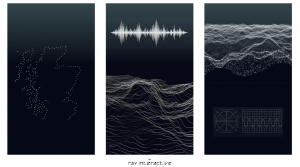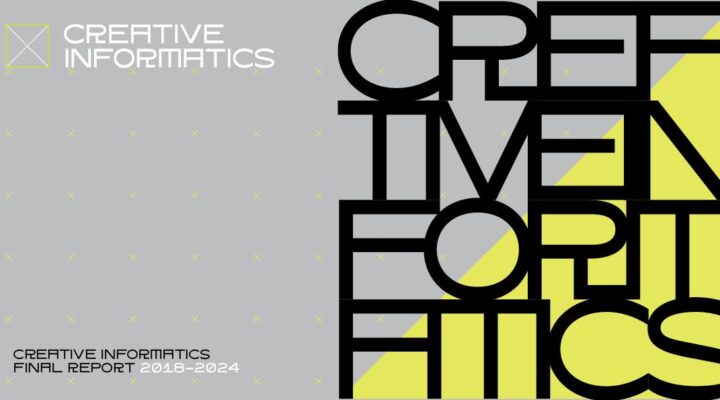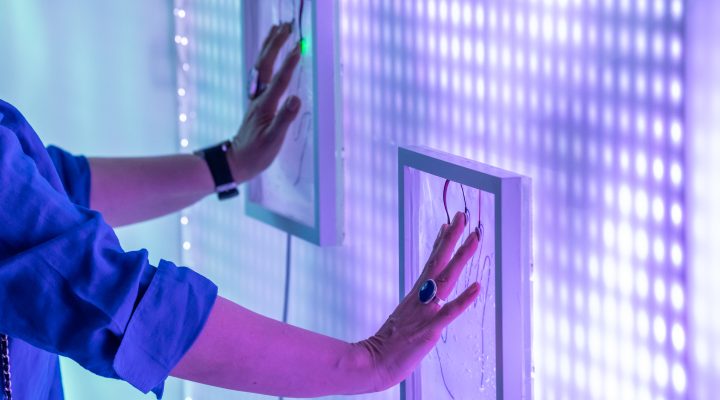
PROJECT | VICTORIA EVANS |
Tidesong.app is an online evolving interactive artwork that allows users to make music with the tidal data from their local coastline, generating time and location specific audience experiences via a website and mobile app.
This practice-based research project aims to connect audiences to the natural rhythms present in tidal landscape and asks to what extent an online installation can offer an embodied and situated art experience, especially in a time of social distancing.

(Fig 1: Tidesong sample visuals. Ray Interactive)
Through a process of data sonification (the use of non-speech audio to perceptualise information) tidesong will allow participants to create a musical track unique to them. The track will then be sharable with other audience members, creating an evolving audio-visual artwork that maps the coastal environment.
GENESIS OF THE PROJECT: WHY MAKE MUSIC FROM TIDAL DATA?

Fig 2: Oscillations 2019, photo Siyao Li
Tidesong is the digital iteration of an ongoing body of work called Oscillations – an immersive moving image and sound installation that sonifies tidal, lunar and solar data to create a meditative audio-visual experience.

Figs 3: Leith and Glasgow tide charts, tidetimes.org

Figs 4: Leith and Glasgow tide charts, tidetimes.org
These graphs are a familiar way of representing tide tables over time. But I wanted to know if condensing the time scale and transposing the measurements to correspond to notes on a musical scale would allow something of the poetic quality of these fluctuations to come to the fore.

Fig. 5: extract from notebook, Victoria Evans
In Oscillations I attempt to highlight and respond to these patterns of measurement, while at the same time speaking to the phenomenology of being beside the sea, in a way that that cannot be expressed by data alone.
LOCKDOWN: MISSING THE PHYSICAL AND SOCIAL IN ART AND LIFE
Pre-lockdown, Oscillations had been staged as an immersive audio–visual exhibition in physical space, allowing the audience to experience the work from multiple vantage points, in a semi-public social space. In moving (or being moved) through a three–dimensional environment we are opening ourselves to a very different kind of cognitive and affective experience than when we are sitting still, focused on a computer screen.
The closure of galleries at the start of lockdown meant that this kind of motile, somatically activated art exhibition became impossible. Even now, as galleries have begun to open up again, the audience experience is still subject to severe restrictions.
I wondered if it might be possible to reclaim some of the embodied and social qualities of audience experience inherent in physical installation, when showing work online or creating remote forms of art installation.

Fig 6, Ardrossan Beach, Victoria Evans
COLLABORATION 1: UX DESIGN
The first steps in the process were to decide on what form the user experience would take.
I was delighted to be able to continue my collaboration with the creative technologists Sam Healy and Brendan McCarthy at Ray Interactive, begun during my artist’s residency at Inspace (Design Informatics, Edinburgh) earlier this year.
I had no initial preconceptions about type of interface and technology that might be appropriate, just some aesthetic preferences and a wish list of objectives (some potentially contradictory) that I hoped could be present in the artwork:
- It should encourage engagement with the environment – encouraging people to visit their local beach/coastline
- It should work on the level of the local, subjective and personal but allow for a connection to wider geographies, embracing the potential for multi-subjective and shared components of art experience
- It should reward physical presence but not exclude those with access issues
- It should be accessible to as wide a variety of users as possible
- It should offer an experience commensurate with the calm and meditative nature of the physical installation
- Visual elements should be minimal and non-intrusive so as not to overly capture the gaze (to the exclusion of the outside world).
- It should be potentially scalable to a world-wide reach (data permitting)
- It should be transparent and respect privacy and user preferences
- The user generated tracks should be time and location specific and storable to create an evolving sonic database/map of the coastline
We settled on a combination of website (as access point and home for the evolving coastline ‘map’) and mobile app (to be used in situ at an audience members’ local beach). The app would be able to use existing smartphone motion sensors, allowing users’ orientation in space to affect their sonic experience.
The idea is that the user will be inspired to visit their local beach or nearest coastline and experience a sonification based on that specific time and location.
An individual user can alter the musical arrangement by changing their bodily orientation on the beach.
For example, when looking out to sea, the tidal based melody is enhanced, when facing away, the lunar and solar melodies (attuned to local sunset, sunset, moonrise and moonset) come to the fore.

Fig 7: Draft Tidesong UX Flowchart, Ray Interactive
COLLABORATION 2: DATA
The other important step was to secure the tidal data. I’d met Colin Bell from the National Oceanography Centre in Liverpool when researching Oscillations and, with a keen interest in music himself, he has been very supportive of the project. Colin generously agreed to consult with Ray Interactive and supply the tidal harmonics algorithm used to generate tidal prediction data for a set of forty-five locations from across the UK free of charge*.
Using the prediction algorithms directly, rather than accessing an existing data set, or scraping websites, means the app can easily be used offline and is not limited to any particular time period. However, on the downside, since these algorithms have a commercial value, we are limited to forty-five destinations the NOC could provide free of charge. These locations are spread out over the UK and so the element of of ‘localness’ from my research wish list is not yet quite fulfilled.
We are currently investigating sources that might allow us to supplement these locations with more localised data, accessible where a mobile signal is available, defaulting to the nearest NOC supplied location when not. In the meantime, Colin’s algorithms have already allowed us to test the concept, and it works, so watch this space…
Tidesong… coming to a beach near you in 2021.

Fig 8: Tidesong Test Screen, Ray Interactive








